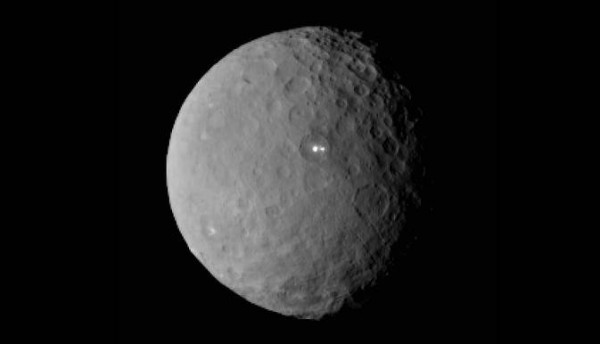After Dawn Glitch, NASA Wants Your Vote About Ceres' Mysterious Bright Spots
| Ana Verayo | | Apr 28, 2015 08:58 PM EDT |
(Photo : NASA/JPL-Caltech/UCLA/MPS/DLR/IDA) This image was taken by NASA's Dawn spacecraft of dwarf planet Ceres on Feb. 19 from a distance of nearly 29,000 miles.
NASA's Dawn spacecraft is currently in orbit with dwarf planet Ceres where its first phase of its science mission was apparently delayed on Friday, April 24 due to a communication glitch that placed the tiny probe into safe mode.
After sending the command from mission ground control, Dawn commenced to start its scientific mission on Friday morning. Apparently, the command was not received upon transmission where the spacecraft automatically went into safe mode in which all commands and communications from Earth were temporarily suspended.
Like Us on Facebook
According to mission chief engineer Mark Rayman from NASA's Jet Propulsion Laboratory, this was nothing more than an inconvenience which will not affect the science mission on the dwarf planet. The delay only lasted a few hours and was officially resolved on Firday night.
To date, Dawn has already captured images of Ceres where the spacecraft has entered its orbit last March 6.
In 2007, Dawn was launched to explore the asteroid belt between Mars and Jupiter where it is set to discover the two largest planetissimals on the region, which are Vesta and Ceres.
Dawn has now moved itself into an orbital position of 8,400 miles above the planet's surface where its suite of scientific instruments will zoom in closer to capture Ceres' surface.
Apparently, before arriving at Ceres, Dawn has already captured some mysterious features that has fascinated scientists including space enthusiasts all over the world which involves two bright spots inside a crater near the dwarf planet's equator.
Now, NASA's Jet Propulsion Laboratory has created a public poll asking Dawn mission fans what those enigmatic, luminous spots are.
The mystery of these spots has been confusing and intriguing for both scientists and observers alike as NASA admits that until now, they still do not know the source or the reason for these bright features. Theories include cryovolcanism and even reflective salt and mineral deposits that are peeking from a vent or crack on the surface.
Scientists aim to investigate further those blobs as Dawn is now in its scientific stage of its mission on Ceres.
TagsNASA, dawn mission, ceres dwarf planet, bright spots ceres, photos ceres dwarf planet
©2015 Chinatopix All rights reserved. Do not reproduce without permission
EDITOR'S PICKS
-

Did the Trump administration just announce plans for a trade war with ‘hostile’ China and Russia?
-

US Senate passes Taiwan travel bill slammed by China
-

As Yan Sihong’s family grieves, here are other Chinese students who went missing abroad. Some have never been found
-

Beijing blasts Western critics who ‘smear China’ with the term sharp power
-

China Envoy Seeks to Defuse Tensions With U.S. as a Trade War Brews
-

Singapore's Deputy PM Provides Bitcoin Vote of Confidence Amid China's Blanket Bans
-

China warns investors over risks in overseas virtual currency trading
-

Chinese government most trustworthy: survey
-

Kashima Antlers On Course For Back-To-Back Titles
MOST POPULAR
LATEST NEWS
Zhou Yongkang: China's Former Security Chief Sentenced to Life in Prison

China's former Chief of the Ministry of Public Security, Zhou Yongkang, has been given a life sentence after he was found guilty of abusing his office, bribery and deliberately ... Full Article
TRENDING STORY

China Pork Prices Expected to Stabilize As The Supplies Recover

Elephone P9000 Smartphone is now on Sale on Amazon India

There's a Big Chance Cliffhangers Won't Still Be Resolved When Grey's Anatomy Season 13 Returns

Supreme Court Ruled on Samsung vs Apple Dispute for Patent Infringement

Microsoft Surface Pro 5 Rumors and Release Date: What is the Latest?










